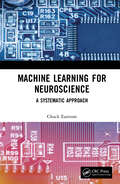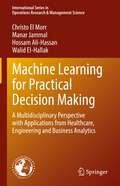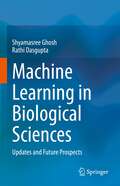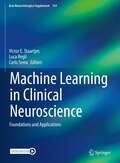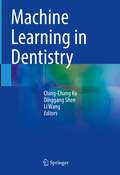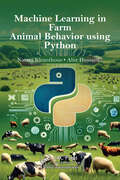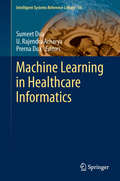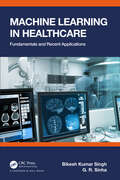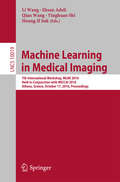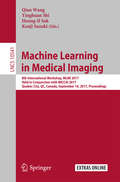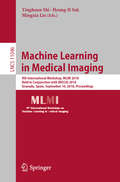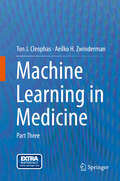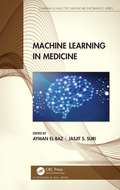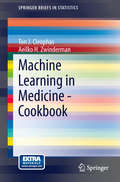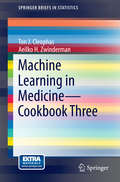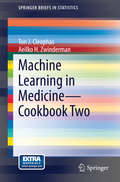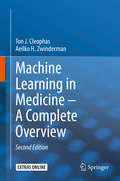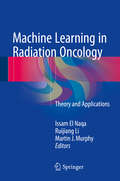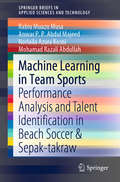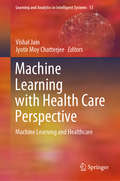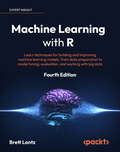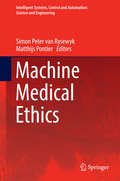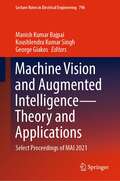- Table View
- List View
Machine Learning for Neurodegenerative Disorders: Advancements and Applications (Artificial Intelligence in Biomedical Image Processing)
by Sudip Paul Sanjay Saxena Biswajit JenaThis book explores the application of machine learning to the understanding, early diagnosis, and management of neurodegenerative disorders. With a specific focus on its role in ongoing clinical trials, the book covers essential topics such as data collection, pre-processing, feature extraction, model development, and validation techniques. It delves into the applications of neuroimaging techniques like magnetic resonance imaging (MRI), computed tomography (CT), and positron emission tomography (PET) in the diagnosis and understanding of neurodegenerative disorders. Additionally, the book examines various machine-learning algorithms employed for biomarker discovery in neurodegenerative disorders. It highlights the role of neuroinformatics and big data analysis in advancing the understanding and management of neurodegenerative disorders. Furthermore, the book reviews future prospects and presents the ethical considerations and regulatory challenges associated with implementing machine learning approaches in the diagnosis, treatment, and prevention of neurodegenerative disorders. This comprehensive resource is intended for neuroscientists, students, researchers, and neurologists to understand the emerging scope of machine learning in neurodegenerative disorders.
Machine Learning for Neuroscience: A Systematic Approach
by Chuck EasttomThis book addresses the growing need for machine learning and data mining in neuroscience. The book offers a basic overview of the neuroscience, machine learning and the required math and programming necessary to develop reliable working models. The material is presented in a easy to follow user-friendly manner and is replete with fully working machine learning code. Machine Learning for Neuroscience: A Systematic Approach, tackles the needs of neuroscience researchers and practitioners that have very little training relevant to machine learning. The first section of the book provides an overview of necessary topics in order to delve into machine learning, including basic linear algebra and Python programming. The second section provides an overview of neuroscience and is directed to the computer science oriented readers. The section covers neuroanatomy and physiology, cellular neuroscience, neurological disorders and computational neuroscience. The third section of the book then delves into how to apply machine learning and data mining to neuroscience and provides coverage of artificial neural networks (ANN), clustering, and anomaly detection. The book contains fully working code examples with downloadable working code. It also contains lab assignments and quizzes, making it appropriate for use as a textbook. The primary audience is neuroscience researchers who need to delve into machine learning, programmers assigned neuroscience related machine learning projects and students studying methods in computational neuroscience.
Machine Learning for Practical Decision Making: A Multidisciplinary Perspective with Applications from Healthcare, Engineering and Business Analytics (International Series in Operations Research & Management Science #334)
by Hossam Ali-Hassan Christo El Morr Manar Jammal Walid EI-HallakThis book provides a hands-on introduction to Machine Learning (ML) from a multidisciplinary perspective that does not require a background in data science or computer science. It explains ML using simple language and a straightforward approach guided by real-world examples in areas such as health informatics, information technology, and business analytics. The book will help readers understand the various key algorithms, major software tools, and their applications. Moreover, through examples from the healthcare and business analytics fields, it demonstrates how and when ML can help them make better decisions in their disciplines. The book is chiefly intended for undergraduate and graduate students who are taking an introductory course in machine learning. It will also benefit data analysts and anyone interested in learning ML approaches.
Machine Learning in Biological Sciences: Updates and Future Prospects
by Shyamasree Ghosh Rathi DasguptaThis book gives an overview of applications of Machine Learning (ML) in diverse fields of biological sciences, including healthcare, animal sciences, agriculture, and plant sciences. Machine learning has major applications in process modelling, computer vision, signal processing, speech recognition, and language understanding and processing and life, and health sciences. It is increasingly used in understanding DNA patterns and in precision medicine. This book is divided into eight major sections, each containing chapters that describe the application of ML in a certain field. The book begins by giving an introduction to ML and the various ML methods. It then covers interesting and timely aspects such as applications in genetics, cell biology, the study of plant-pathogen interactions, and animal behavior. The book discusses computational methods for toxicity prediction of environmental chemicals and drugs, which forms a major domain of research in the field of biology. It is of relevance to post-graduate students and researchers interested in exploring the interdisciplinary areas of use of machine learning and deep learning in life sciences.
Machine Learning in Clinical Neuroscience: Foundations and Applications (Acta Neurochirurgica Supplement #134)
by Luca Regli Victor E. Staartjes Carlo SerraThis book bridges the gap between data scientists and clinicians by introducing all relevant aspects of machine learning in an accessible way, and will certainly foster new and serendipitous applications of machine learning in the clinical neurosciences. Building from the ground up by communicating the foundational knowledge and intuitions first before progressing to more advanced and specific topics, the book is well-suited even for clinicians without prior machine learning experience. Authored by a wide array of experienced global machine learning groups, the book is aimed at clinicians who are interested in mastering the basics of machine learning and who wish to get started with their own machine learning research. The volume is structured in two major parts: The first uniquely introduces all major concepts in clinical machine learning from the ground up, and includes step-by-step instructions on how to correctly develop and validate clinical prediction models. It also includes methodological and conceptual foundations of other applications of machine learning in clinical neuroscience, such as applications of machine learning to neuroimaging, natural language processing, and time series analysis. The second part provides an overview of some state-of-the-art applications of these methodologies. The Machine Intelligence in Clinical Neuroscience (MICN) Laboratory at the Department of Neurosurgery of the University Hospital Zurich studies clinical applications of machine intelligence to improve patient care in clinical neuroscience. The group focuses on diagnostic, prognostic and predictive analytics that aid in decision-making by increasing objectivity and transparency to patients. Other major interests of our group members are in medical imaging, and intraoperative applications of machine vision.
Machine Learning in Dentistry
by Li Wang Dinggang Shen Ching-Chang KoThis book reviews all aspects of the use of machine learning in contemporary dentistry, clearly explaining its significance for dental imaging, oral diagnosis and treatment, dental designs, and dental research. Machine learning is an emerging field of artificial intelligence research and practice in which computer agents are employed to improve perception, cognition, and action based on their ability to “learn”, for example through use of big data techniques. Its application within dentistry is designed to promote personalized and precision patient care, with enhancement of diagnosis and treatment planning. In this book, readers will find up-to-date information on different machine learning tools and their applicability in various dental specialties. The selected examples amply illustrate the opportunities to employ a machine learning approach within dentistry while also serving to highlight the associated challenges. Machine Learning in Dentistry will be of value for all dental practitioners and researchers who wish to learn more about the potential benefits of using machine learning techniques in their work.
Machine Learning in Farm Animal Behavior using Python
by Natasa Kleanthous Abir HussainThis book is a comprehensive guide to applying machine learning to animal behavior analysis, focusing on activity recognition in farm animals. It begins by introducing key concepts of animal behavior and ethology, followed by an exploration of machine learning techniques, including supervised, unsupervised, semi-supervised, and reinforcement learning. The practical section covers essential steps like data collection, preprocessing, exploratory data analysis, feature extraction, model training, and evaluation, using Python.The book emphasizes the importance of high-quality data and discusses various sensors and annotation methods for effective data collection. It addresses key machine learning challenges such as generalization and data issues. Advanced topics include feature selection, model selection, hyperparameter tuning, and deep learning algorithms. Practical examples and Python implementations are provided throughout, offering hands-on experience for researchers, students, and professionals aiming to apply machine learning to animal behavior analysis.
Machine Learning in Healthcare Informatics
by Sumeet Dua U. Rajendra Acharya Prerna DuaThe book is a unique effort to represent a variety of techniques designed to represent, enhance, and empower multi-disciplinary and multi-institutional machine learning research in healthcare informatics. The book provides a unique compendium of current and emerging machine learning paradigms for healthcare informatics and reflects the diversity, complexity and the depth and breath of this multi-disciplinary area. The integrated, panoramic view of data and machine learning techniques can provide an opportunity for novel clinical insights and discoveries.
Machine Learning in Healthcare: Fundamentals and Recent Applications
by G.R. Sinha Bikesh Kumar SinghArtificial intelligence (AI) and machine learning (ML) techniques play an important role in our daily lives by enhancing predictions and decision-making for the public in several fields such as financial services, real estate business, consumer goods, social media, etc. Despite several studies that have proved the efficacy of AI/ML tools in providing improved healthcare solutions, it has not gained the trust of health-care practitioners and medical scientists. This is due to poor reporting of the technology, variability in medical data, small datasets, and lack of standard guidelines for application of AI. Therefore, the development of new AI/ML tools for various domains of medicine is an ongoing field of research. Machine Learning in Healthcare: Fundamentals and Recent Applications discusses how to build various ML algorithms and how they can be applied to improve healthcare systems. Healthcare applications of AI are innumerable: medical data analysis, early detection and diagnosis of disease, providing objective-based evidence to reduce human errors, curtailing inter- and intra-observer errors, risk identification and interventions for healthcare management, real-time health monitoring, assisting clinicians and patients for selecting appropriate medications, and evaluating drug responses. Extensive demonstrations and discussion on the various principles of machine learning and its application in healthcare is provided, along with solved examples and exercises. This text is ideal for readers interested in machine learning without any background knowledge and looking to implement machine-learning models for healthcare systems.
Machine Learning in Medical Imaging
by Qian Wang Li Wang Ehsan Adeli Yinghuan Shi Heung-Il SukThis book constitutes the refereed proceedings of the 7th International Workshop on Machine Learning in Medical Imaging, MLMI 2016, held in conjunction with MICCAI 2016, in Athens, Greece, in October 2016. The 38 full papers presented in this volume were carefully reviewed and selected from 60 submissions. The main aim of this workshop is to help advance scientific research within the broad field of machine learning in medical imaging. The workshop focuses on major trends and challenges in this area, and presents works aimed to identify new cutting-edge techniques and their use in medical imaging.
Machine Learning in Medical Imaging: 7th International Workshop, MLMI 2016, Held in Conjunction with MICCAI 2016, Athens, Greece, October 17, 2016, Proceedings (Lecture Notes in Computer Science #10019)
by Li Wang, Ehsan Adeli, Qian Wang, Yinghuan Shi and Heung-Il SukThis book constitutes the refereed proceedings of the 7th International Workshop on Machine Learning in Medical Imaging, MLMI 2016, held in conjunction with MICCAI 2016, in Athens, Greece, in October 2016. The 38 full papers presented in this volume were carefully reviewed and selected from 60 submissions. The main aim of this workshop is to help advance scientific research within the broad field of machine learning in medical imaging. The workshop focuses on major trends and challenges in this area, and presents works aimed to identify new cutting-edge techniques and their use in medical imaging.
Machine Learning in Medical Imaging: 8th International Workshop, MLMI 2017, Held in Conjunction with MICCAI 2017, Quebec City, QC, Canada, September 10, 2017, Proceedings (Lecture Notes in Computer Science #10541)
by Qian Wang, Yinghuan Shi, Heung-Il Suk and Kenji SuzukiThis book constitutes the refereed proceedings of the 8th International Workshop on Machine Learning in Medical Imaging, MLMI 2017, held in conjunction with MICCAI 2017, in Quebec City, QC, Canada, in September 2017. The 44 full papers presented in this volume were carefully reviewed and selected from 63 submissions. The main aim of this workshop is to help advance scientific research within the broad field of machine learning in medical imaging. The workshop focuses on major trends and challenges in this area, and presents works aimed to identify new cutting-edge techniques and their use in medical imaging.
Machine Learning in Medical Imaging: 9th International Workshop, MLMI 2018, Held in Conjunction with MICCAI 2018, Granada, Spain, September 16, 2018, Proceedings (Lecture Notes in Computer Science #11046)
by Yinghuan Shi Heung-Il Suk Mingxia LiuThis book constitutes the proceedings of the 9th International Workshop on Machine Learning in Medical Imaging, MLMI 2018, held in conjunction with MICCAI 2018 in Granada, Spain, in September 2018.The 45 papers presented in this volume were carefully reviewed and selected from 82 submissions. They focus on major trends and challenges in the area of machine learning in medical imaging and aim to identify new cutting-edge techniques and their use in medical imaging.
Machine Learning in Medicine
by Aeilko H. Zwinderman Ton J. CleophasMachine learning is a novel discipline concerned with the analysis of large and multiple variables data. It involves computationally intensive methods, like factor analysis, cluster analysis, and discriminant analysis. It is currently mainly the domain of computer scientists, and is already commonly used in social sciences, marketing research, operational research and applied sciences. It is virtually unused in clinical research. This is probably due to the traditional belief of clinicians in clinical trials where multiple variables are equally balanced by the randomization process and are not further taken into account. In contrast, modern computer data files often involve hundreds of variables like genes and other laboratory values, and computationally intensive methods are required. This book was written as a hand-hold presentation accessible to clinicians, and as a must-read publication for those new to the methods.
Machine Learning in Medicine (Chapman & Hall/CRC Healthcare Informatics Series)
by Jasjit S. Suri Ayman El-BazMachine Learning in Medicine covers the state-of-the-art techniques of machine learning and their applications in the medical field. It presents several computer-aided diagnosis (CAD) systems, which have played an important role in the diagnosis of several diseases in the past decade, e.g., cancer detection, resulting in the development of several successful systems. New developments in machine learning may make it possible in the near future to develop machines that are capable of completely performing tasks that currently cannot be completed without human aid, especially in the medical field. This book covers such machines, including convolutional neural networks (CNNs) with different activation functions for small- to medium-size biomedical datasets, detection of abnormal activities stemming from cognitive decline, thermal dose modelling for thermal ablative cancer treatments, dermatological machine learning clinical decision support systems, artificial intelligence-powered ultrasound for diagnosis, practical challenges with possible solutions for machine learning in medical imaging, epilepsy diagnosis from structural MRI, Alzheimer's disease diagnosis, classification of left ventricular hypertrophy, and intelligent medical language understanding. This book will help to advance scientific research within the broad field of machine learning in the medical field. It focuses on major trends and challenges in this area and presents work aimed at identifying new techniques and their use in biomedical analysis, including extensive references at the end of each chapter.
Machine Learning in Medicine - Cookbook
by Aeilko H. Zwinderman Ton J. CleophasThe amount of data in medical databases doubles every 20 months, and physicians are at a loss to analyze them. Also, traditional methods of data analysis have difficulty to identify outliers and patterns in big data and data with multiple exposure / outcome variables and analysis-rules for surveys and questionnaires, currently common methods of data collection, are, essentially, missing. Obviously, it is time that medical and health professionals mastered their reluctance to use machine learning and the current 100 page cookbook should be helpful to that aim. It covers in a condensed form the subjects reviewed in the 750 page three volume textbook by the same authors, entitled "Machine Learning in Medicine I-III" (ed. by Springer, Heidelberg, Germany, 2013) and was written as a hand-hold presentation and must-read publication. It was written not only to investigators and students in the fields, but also to jaded clinicians new to the methods and lacking time to read the entire textbooks. General purposes and scientific questions of the methods are only briefly mentioned, but full attention is given to the technical details. The two authors, a statistician and current president of the International Association of Biostatistics and a clinician and past-president of the American College of Angiology, provide plenty of step-by-step analyses from their own research and data files for self-assessment are available at extras. springer. com. From their experience the authors demonstrate that machine learning performs sometimes better than traditional statistics does. Machine learning may have little options for adjusting confounding and interaction, but you can add propensity scores and interaction variables to almost any machine learning method.
Machine Learning in Medicine - Cookbook Three
by Aeilko H. Zwinderman Ton J. CleophasUnique features of the book involve the following. 1. This book is the third volume of a three volume series of cookbooks entitled "Machine Learning in Medicine - Cookbooks One, Two, and Three". No other self-assessment works for the medical and health care community covering the field of machine learning have been published to date. 2. Each chapter of the book can be studied without the need to consult other chapters, and can, for the readership''s convenience, be downloaded from the internet. Self-assessment examples are available at extras. springer. com. 3. An adequate command of machine learning methodologies is a requirement for physicians and other health workers, particularly now, because the amount of medical computer data files currently doubles every 20 months, and, because, soon, it will be impossible for them to take proper data-based health decisions without the help of machine learning. 4. Given the importance of knowledge of machine learning in the medical and health care community, and the current lack of knowledge of it, the readership will consist of any physician and health worker. 5. The book was written in a simple language in order to enhance readability not only for the advanced but also for the novices. 6. The book is multipurpose, it is an introduction for ignorant, a primer for the inexperienced, and a self-assessment handbook for the advanced. 7. The book, was, particularly, written for jaded physicians and any other health care professionals lacking time to read the entire series of three textbooks. 8. Like the other two cookbooks it contains technical descriptions and self-assessment examples of 20 important computer methodologies for medical data analysis, and it, largely, skips the theoretical and mathematical background. 9. Information of theoretical and mathematical background of the methods described are displayed in a "notes" section at the end of each chapter. 10. Unlike traditional statistical methods, the machine learning methodologies are able to analyze big data including thousands of cases and hundreds of variables. 11. The medical and health care community is little aware of the multidimensional nature of current medical data files, and experimental clinical studies are not helpful to that aim either, because these studies, usually, assume that subgroup characteristics are unimportant, as long as the study is randomized. This is, of course, untrue, because any subgroup characteristic may be vital to an individual at risk. 12. To date, except for a three volume introductary series on the subject entitled "Machine Learning in Medicine Part One, Two, and Thee, 2013, Springer Heidelberg Germany" from the same authors, and the current cookbook series, no books on machine learning in medicine have been published. 13. Another unique feature of the cookbooks is that it was jointly written by two authors from different disciplines, one being a clinician/clinical pharmacologist, one being a mathematician/biostatistician. 14. The authors have also jointly been teaching at universities and institutions throughout Europe and the USA for the past 20 years. 15. The authors have managed to cover the field of medical data analysis in a nonmathematical way for the benefit of medical and health workers. 16. The authors already successfully published many statistics textbooks and self-assessment books, e. g. , the 67 chapter textbook entitled "Statistics Applied to Clinical Studies 5th Edition, 2012, Springer Heidelberg Germany" with downloads of 62,826 copies. 17. The current cookbook makes use, in addition to SPSS statistical software, of various free calculators from the internet, as well as the Konstanz Information Miner (Knime), a widely approved free machine learning package, and the free Weka Data Mining package from New Zealand. 18. The above software packages with hundreds of nodes, the basic processing units including virtually all of the statistical and data mining methods, can be used not only for data analyses, but also for appropriate data stora...
Machine Learning in Medicine - Cookbook Two
by Aeilko H. Zwinderman Ton J. CleophasThe amount of data medical databases doubles every 20 months, and physicians are at a loss to analyze them. Also, traditional data analysis has difficulty to identify outliers and patterns in big data and data with multiple exposure / outcome variables and analysis-rules for surveys and questionnaires, currently common methods of data collection, are, essentially, missing. Consequently, proper data-based health decisions will soon be impossible. Obviously, it is time that medical and health professionals mastered their reluctance to use machine learning methods and this was the main incentive for the authors to complete a series of three textbooks entitled "Machine Learning in Medicine Part One, Two and Three, Springer Heidelberg Germany, 2012-2013", describing in a nonmathematical way over sixty machine learning methodologies, as available in SPSS statistical software and other major software programs. Although well received, it came to our attention that physicians and students often lacked time to read the entire books, and requested a small book, without background information and theoretical discussions and highlighting technical details. For this reason we produced a 100 page cookbook, entitled "Machine Learning in Medicine - Cookbook One", with data examples available at extras. springer. com for self-assessment and with reference to the above textbooks for background information. Already at the completion of this cookbook we came to realize, that many essential methods were not covered. The current volume, entitled "Machine Learning in Medicine - Cookbook Two" is complementary to the first and also intended for providing a more balanced view of the field and thus, as a must-read not only for physicians and students, but also for any one involved in the process and progress of health and health care. Similarly to Machine Learning in Medicine - Cookbook One, the current work will describe stepwise analyses of over twenty machine learning methods, that are, likewise, based on the three major machine learning methodologies: Cluster methodologies (Chaps. 1-3) Linear methodologies (Chaps. 4-11) Rules methodologies (Chaps. 12-20) In extras. springer. com the data files of the examples are given, as well as XML (Extended Mark up Language), SPS (Syntax) and ZIP (compressed) files for outcome predictions in future patients. In addition to condensed versions of the methods, fully described in the above three textbooks, an introduction is given to SPSS Modeler (SPSS' data mining workbench) in the Chaps. 15, 18, 19, while improved statistical methods like various automated analyses and Monte Carlo simulation models are in the Chaps. 1, 5, 7 and 8. We should emphasize that all of the methods described have been successfully applied in practice by the authors, both of them professors in applied statistics and machine learning at the European Community College of Pharmaceutical Medicine in Lyon France. We recommend the current work not only as a training companion to investigators and students, because of plenty of step by step analyses given, but also as a brief introductory text to jaded clinicians new to the methods. For the latter purpose, background and theoretical information have been replaced with the appropriate references to the above textbooks, while single sections addressing "general purposes", "main scientific questions" and "conclusions" are given in place. Finally, we will demonstrate that modern machine learning performs sometimes better than traditional statistics does. Machine learning may have little options for adjusting confounding and interaction, but you can add propensity scores and interaction variables to almost any machine learning method.
Machine Learning in Medicine – A Complete Overview
by Aeilko H. Zwinderman Ton J. CleophasAdequate health and health care is no longer possible without proper data supervision from modern machine learning methodologies like cluster models, neural networks, and other data mining methodologies. The current book is the first publication of a complete overview of machine learning methodologies for the medical and health sector, and it was written as a training companion, and as a must-read, not only for physicians and students, but also for any one involved in the process and progress of health and health care.In this second edition the authors have removed the textual errors from the first edition. Also, the improved tables from the first edition, have been replaced with the original tables from the software programs as applied. This is, because, unlike the former, the latter were without error, and readers were better familiar with them.The main purpose of the first edition was, to provide stepwise analyses of the novel methods from data examples, but background information and clinical relevance information may have been somewhat lacking. Therefore, each chapter now contains a section entitled "Background Information".Machine learning may be more informative, and may provide better sensitivity of testing than traditional analytic methods may do. In the second edition a place has been given for the use of machine learning not only to the analysis of observational clinical data, but also to that of controlled clinical trials.Unlike the first edition, the second edition has drawings in full color providing a helpful extra dimension to the data analysis.Several machine learning methodologies not yet covered in the first edition, but increasingly important today, have been included in this updated edition, for example, negative binomial and Poisson regressions, sparse canonical analysis, Firth's bias adjusted logistic analysis, omics research, eigenvalues and eigenvectors.
Machine Learning in Radiation Oncology
by Issam El Naqa Ruijiang Li Martin J. MurphyThis book provides a complete overview of the role of machine learning in radiation oncology and medical physics, covering basic theory, methods, and a variety of applications in medical physics and radiotherapy. An introductory section explains machine learning, reviews supervised and unsupervised learning methods, discusses performance evaluation, and summarizes potential applications in radiation oncology. Detailed individual sections are then devoted to the use of machine learning in quality assurance; computer-aided detection, including treatment planning and contouring; image-guided radiotherapy; respiratory motion management; and treatment response modeling and outcome prediction. The book will be invaluable for students and residents in medical physics and radiation oncology and will also appeal to more experienced practitioners and researchers and members of applied machine learning communities.
Machine Learning in Team Sports: Performance Analysis and Talent Identification in Beach Soccer & Sepak-takraw (SpringerBriefs in Applied Sciences and Technology)
by Mohamad Razali Abdullah Rabiu Muazu Musa Anwar P.P. Abdul Majeed Norlaila Azura KosniThis brief highlights the application of performance analysis tools in data acquisition, and various machine learning algorithms for evaluating team performance as well as talent identification in beach soccer and sepak takraw. Numerous performance indicators and human performance parameters are considered based on their relevance to each sport. The findings presented here demonstrate that the key performance indicators as well as human performance parameters can be used in the future evaluation of team performance as well as talent identification in these sports. Accordingly, they offer a valuable resource for coaches, club managers, talent identification experts, performance analysts and other relevant stakeholders involved in performance assessments.
Machine Learning with Health Care Perspective: Machine Learning and Healthcare (Learning and Analytics in Intelligent Systems #13)
by Jyotir Moy Chatterjee Vishal JainThis unique book introduces a variety of techniques designed to represent, enhance and empower multi-disciplinary and multi-institutional machine learning research in healthcare informatics. Providing a unique compendium of current and emerging machine learning paradigms for healthcare informatics, it reflects the diversity, complexity, and the depth and breadth of this multi-disciplinary area. Further, it describes techniques for applying machine learning within organizations and explains how to evaluate the efficacy, suitability, and efficiency of such applications. Featuring illustrative case studies, including how chronic disease is being redefined through patient-led data learning, the book offers a guided tour of machine learning algorithms, architecture design, and applications of learning in healthcare challenges.
Machine Learning with R: Learn techniques for building and improving machine learning models, from data preparation to model tuning, evaluation, and working with big data, 4th Edition
by Brett LantzLearn how to solve real-world data problems using machine learning and RPurchase of the print or Kindle book includes a free eBook in PDF format.Key FeaturesThe 10th Anniversary Edition of the bestselling R machine learning book, updated with 50% new content for R 4.0.0 and beyondHarness the power of R to build flexible, effective, and transparent machine learning modelsLearn quickly with this clear, hands-on guide by machine learning expert Brett LantzBook DescriptionMachine learning, at its core, is concerned with transforming data into actionable knowledge. R offers a powerful set of machine learning methods to quickly and easily gain insight from your data. Machine Learning with R, Fourth Edition, provides a hands-on, accessible, and readable guide to applying machine learning to real-world problems. Whether you are an experienced R user or new to the language, Brett Lantz teaches you everything you need to know for data pre-processing, uncovering key insights, making new predictions, and visualizing your findings. This 10th Anniversary Edition features several new chapters that reflect the progress of machine learning in the last few years and help you build your data science skills and tackle more challenging problems, including making successful machine learning models and advanced data preparation, building better learners, and making use of big data.You'll also find this classic R data science book updated to R 4.0.0 with newer and better libraries, advice on ethical and bias issues in machine learning, and an introduction to deep learning. Whether you're looking to take your first steps with R for machine learning or making sure your skills and knowledge are up to date, this is an unmissable read that will help you find powerful new insights in your data.What you will learnLearn the end-to-end process of machine learning from raw data to implementationClassify important outcomes using nearest neighbor and Bayesian methodsPredict future events using decision trees, rules, and support vector machinesForecast numeric data and estimate financial values using regression methodsModel complex processes with artificial neural networksPrepare, transform, and clean data using the tidyverseEvaluate your models and improve their performanceConnect R to SQL databases and emerging big data technologies such as Spark, Hadoop, H2O, and TensorFlowWho this book is forThis book is designed to help data scientists, actuaries, data analysts, financial analysts, social scientists, business and machine learning students, and any other practitioners who want a clear, accessible guide to machine learning with R. No R experience is required, although prior exposure to statistics and programming is helpful.
Machine Medical Ethics
by Simon Peter van Rysewyk Matthijs PontierThe essays in this book, written by researchers from both humanities and science, describe various theoretical and experimental approaches to adding medical ethics to a machine, what design features are necessary in order to achieve this, philosophical and practical questions concerning justice, rights, decision-making and responsibility in medical contexts, and accurately modeling essential physician-machine-patient relationships. In medical settings, machines are in close proximity with human beings: with patients who are in vulnerable states of health, who have disabilities of various kinds, with the very young or very old and with medical professionals. Machines in these contexts are undertaking important medical tasks that require emotional sensitivity, knowledge of medical codes, human dignity and privacy. As machine technology advances, ethical concerns become more urgent: should medical machines be programmed to follow a code of medical ethics? What theory or theories should constrain medical machine conduct? What design features are required? Should machines share responsibility with humans for the ethical consequences of medical actions? How ought clinical relationships involving machines to be modeled? Is a capacity for empathy and emotion detection necessary? What about consciousness? This collection is the first book that addresses these 21st-century concerns.
Machine Vision and Augmented Intelligence—Theory and Applications: Select Proceedings of MAI 2021 (Lecture Notes in Electrical Engineering #796)
by Manish Kumar Bajpai Koushlendra Kumar Singh George GiakosThis book comprises the proceedings of the International Conference on Machine Vision and Augmented Intelligence (MAI 2021) held at IIIT, Jabalpur, in February 2021. The conference proceedings encapsulate the best deliberations held during the conference. The diversity of participants in the event from academia, industry, and research reflects in the articles appearing in the volume. The book theme encompasses all industrial and non-industrial applications in which a combination of hardware and software provides operational guidance to devices in the execution of their functions based on the capture and processing of images. This book covers a wide range of topics such as modeling of disease transformation, epidemic forecast, COVID-19, image processing and computer vision, augmented intelligence, soft computing, deep learning, image reconstruction, artificial intelligence in healthcare, brain-computer interface, cybersecurity, and social network analysis, natural language processing, etc.

